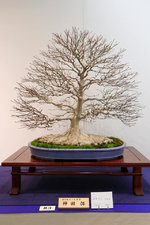@Bonsai Tree can you say more about what you mean by ‘pancake nebari’? Maybe share some pictures and try to describe what it is that you don’t like.
Your question is a good one, and deserves serious discussion. I’ve spent countless hours reflecting on this very topic.
I think some category distinctions can be helpful, and will give you things to think about.
In this first image, the lines of the tree go from vertical (trunk) to horizontal (nebarj) relatively rapidly:

By contrast, the transition from vertical to horizontal on this tree is much more gradual:

It’s not a huge difference, and as time passes they will look increasingly similar, but it is something to think about.
Another thing to think about is the size of the nebari (it’s diameter, so to speak) in contrast with the thickness of the trunk. Consider the first image i posted, vs this picture:

Another thing to consider is the appearance of the perimeter of the nebari. In the first image i posted, lets say the nebari has tiny ‘fingers’ on its perimeter. By constrast, this tree has larger fingers:

There are also trees with fairly ‘round/smooth’ perimeter (i.e. relatively ‘fingerless’):

Of course some of this has to do with moss work, but a lot of it also has to do with pruning practices.
On that note, another thing to think about is planting height. A tree that sits lower in relation to the soil level might give more of a ‘pancake’ appearance i think, whereas a higher planting height counteracts the ‘pancake’ visual to some extent.
Finally here is a tree with a fairly wide nebari, but the nebari seems to have a downward angle from the trunk all the way to its perimeter (unlike the first picture, where the nebari gets horizontal and stays horizontal)

There is a lot more to say on this topic, and many more category distinctions to discuss.
One important thing to say in response to your question is that yes, the nebari will continue to grow/get wider and the roots will continue to fuse over the tree’s lifetime. Understanding how you want to manage that growth and development is important, and although it’s something that happens perpetually over decades and decades there are decisions made early on and at every repot that do have long term effects (which can sometimes be changed or corrected later, and sometimes not).
There is incredible variety when it comes to maple nebari, as we can see from the trees that have been exhibited in the Kokufu over time (link below). I would say that the overwhelming majority of them do not have what i would call ‘pancake nebari’, and it is not shocking to hear that ‘pancake nebari’ is not something that you find aesthetically pleasing nor should you be made to feel guilty for that.
‘Pancake nebari’ is not a prerequisite for making good maple bonsai, and it isn’t even something that we should all be striving for. It’s an aesthetic choice, and it’s certainly attention-grabbing (and i’m personally fascinated with it, but that doesn’t mean anything).
7,387 Followers, 1 Following, 863 Posts - See Instagram photos and videos from (@kokufu_maples)

www.instagram.com
Finally, here is Musashi Ga Oka. The first picture was taken not all that long ago, and the second picture i took in 2024 (from the opposite side, sorry!) The point here is, things change!

